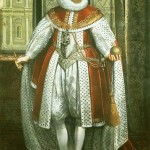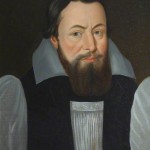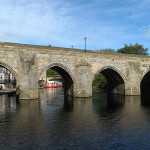
Portrait of James I of England in state robes (1566-1625), oil on canvas, by Paul van Somer, c.1620, from the Royal Collection
‘William our bishope, hath oppugnant been … Confirme our graunt good King‘.
This month’s Flower follows on from April’s, both of which concern James I royal visit to Durham in 1617. It too comes from the Order Book of the City of Durham (Durham County Archives ref. Du 1/4/4).
In April’s Flower we noted that behind the scenes of the official welcome of the monarch, there had been a conflict raging in the city between the Bishop and the civic authorities, with each side accusing the other of encroaching on rights accorded by the Charter. On Holy Saturday (19th April), after his ‘official’ welcome by the Bishop and civic authorities on Elvet Bridge, a second, more controversial poem was delivered to the King later in the day and some distance away. The poem below was delivered to the king by a city apprentice, and it outlined some of the injustices felt by the civic authorities in a way that could be disowned if necessary. By putting their complaint into the mouth of an apprentice and at some distance from the official welcome, the city authorities could make the King aware of it in a way that they would be able to disown if necessary.
[The context:]
‘After which Speech the Maior was called by his
Maiesties gentleman vsher, to take his horse, and to
ride before his Maiestie, Ymediatly vpon which comandement
made by his Maiesties gentleman vsher, there was at the
same place aboute .40. yardes distance, certayne Verses
spoken by an apprentice of this Cittie, to his Maiestie, as
followeth, after which the Maior was placed, in ranck
next the Sword, and so ride forwardes carrieing the
Citties Mace to the Church.‘
[Text of the second poem:]
‘To the Kinges most Ecellent Maiestie
Durhams old Cittie, thus salutes our King
which intertayment, she doth homlie bring;
and cannot smyle vpon his Maiestie
with shewe of greatnes; but humilitie
makes her expresse herselfe, in moderne guise
deiected to this north, bare to your eyes
ffor the great Prelate, which of late adorde
her dignities, and for which we ymplorde
Your Highnes, aide, to haue contynuance,
And so confirmd by your dread Souerance
Yet what our Royall James, did graunt herein
William our bishope, hath oppugnant been
Smale task to sway downe smalnes, where mans might
hath greater force, then equitie or right
But these are only, in your brest included
your subiectes knowe them not, but are secluded
from your most gracious graunt; therefore we pray
that the faire sonne shyne, of your brightest daie
would smyle vpon this Cittie, with clere beames
to’ exhale the tempest of insueing streames
Suffer not great prince our ancient state
by one forcd will, to be depopulate;
Tis one seekes our vndoeing, but to you
ten thousandes heartes shall pray, and knees shall bowe
and this dull cell, of earth wherein wee liue
vnto your name; ymortall prayse shall giue.
Confirme our graunt good King, Durhams old Citty
would be more powerfull, so it had James pittie’
(… and here’s a picture of that ‘oppugnant’ bishop, Richard Neile:) 
Richard Neile (1562–1640), Bishop of Durham (1617–1628) (copy after an earlier painting)
by Buscall Fox, from the Auckland Castle collection.

